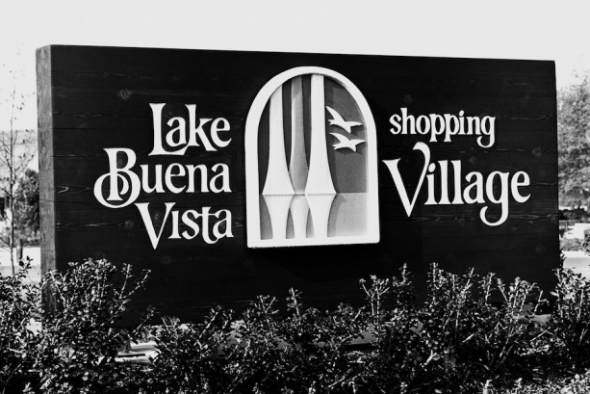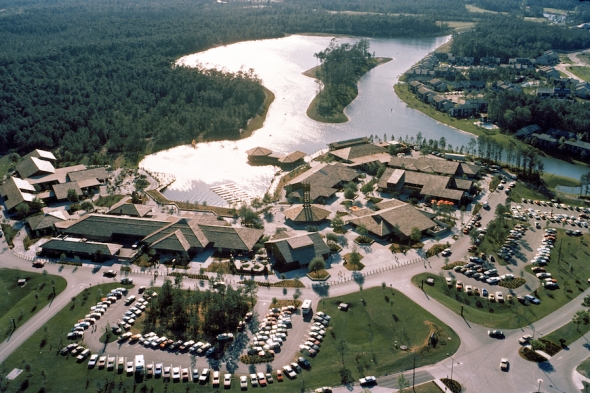The geometry of greed
Image: Disney
Expansion over the years is where the village went wrong. Starting in 1977, campus planners increased the business offerings in hodgepodge fashion. They also changed the name to Walt Disney World Village to reinforce its appeal to consumers. Expansion was inevitable at this point. No reason or rhyme existed in adding more stores, though. It was simply a matter of earning more revenue. That caused problems, the most pressing of which involved the basic design of the place.
At its genesis, the village accentuated the Vacation Kingdom theme of Walt Disney World in its entirety. An entire community surrounded a man-made lake at the center of town. The only expected vehicles were WEDway Peoplemovers, which explains why generations of Disney Springs visitors have lamented the parking situation. It was a conscious choice on the original blueprints. Somebody from the late 1960s deserves a punch in the face for that.
Anyway, part of this village-wide philosophy involved “commercial naturalism,” a concept that has long since fallen by the wayside. At the time, it was a belief that everything should look organic and lived in. Shrubs, trees, and other vegetation seamlessly integrated with the shops and restaurants. Aged brick lined the walls, occasionally interrupted by rustic iron gates and stained-glass windows and lanterns. All these features were breathtaking to behold on day one.
The patterns were also shockingly easy to disrupt.
A single reckless addition could ruin the illusion of theming that Imagineers had planned so meticulously. After the first year of its existence, the village entered into a battle of art versus commerce and, as usual, art got its butt kicked. The region haphazardly introduced new businesses into the village, accidentally ruining its timeless symmetry in the process. In its constant fight for revenue, Disney lost the theme of one of its most beautiful creations, the Lake Buena Vista Shopping Village.
Downtown competition
Image: Disney
As Disney fell by the wayside, an unlikely threat emerged. And they were largely responsible for it. When Walt Disney purchased his land and announced the Florida Project, Orlando had a population of 250,000. That number had more than tripled as the end of the 1980s approached. The city would surpass one million residents in the early 1990s. A lot of the appeal was living in a thriving metropolitan region that was home to Walt Disney World.
As the population increased, other entrepreneurs noted the growing opportunities in the city. Church Street Station was arguably the most famous. It was a series of nightclubs hosted in the unlikely setting of a train station. Guests would literally cross the tracks as they passed the nights away, barhopping in an impressively enterprising setting. For a single cover charge, they’d have free reign of every night club there. And Disney viewed basically every dollar spent at Church Street Station as money taken from their ledger sheet. It was their idea, so they were furious to watch somebody else monetize the greater Orlando community by employing their strategy. Better.
Over time, strategists appreciated that one of the reasons Church Street Station succeeded at the village’s expense was its target audience. Disney had explicitly chosen to emphasize a luxury lifestyle. They wanted to sell to the wealthiest clientele, a rejoinder that sounds familiar to this day. Church Street Station was the populist response, a welcoming environment that would happily take money from people of all income levels. Disney had unintentionally priced out some of their potential customers.
Appreciating the problem, corporate executives finally embarked on a new strategy as the 1990s approached. They decided to reboot the village as a vacation destination with a thriving nightlife. Out was the proverbial Grey Poupon. The new spot was all about mustard instead. And that was the genesis of Pleasure Island, the locale that we now know as The Landing at Disney Springs. In the years leading up to the current iteration of the village, however, Pleasure Island was very much its own thing, and a weird little thing at that.



Comments
First, get an editor. This story rambled from one place to another, never making the point the headline of the story intended to.
Second, the conclusion of the story did match the headline in any way.
Third, the timeline was awful. Eighty percent of the story could have been called "Downtown Disney: A tale of Disney world's early years"
Try harder.
I remember going to "Disney Village" in the 80's and then Pleasure Island in my teenage years. I always found it odd that it had the same name as the "bad place" in Pinocchio where kids smoke cigars and turn into donkeys. That was a bit of weird unintended(?) synergy.
Great article but it seems only halfway done. Would love more insight into the different themed clubs of PI or it's transformation into Disney Springs and the rebooting of the story there.